Chicken Tractor: The Ultimate Tool for Sustainable Backyard Farming
Published: December 27, 2023
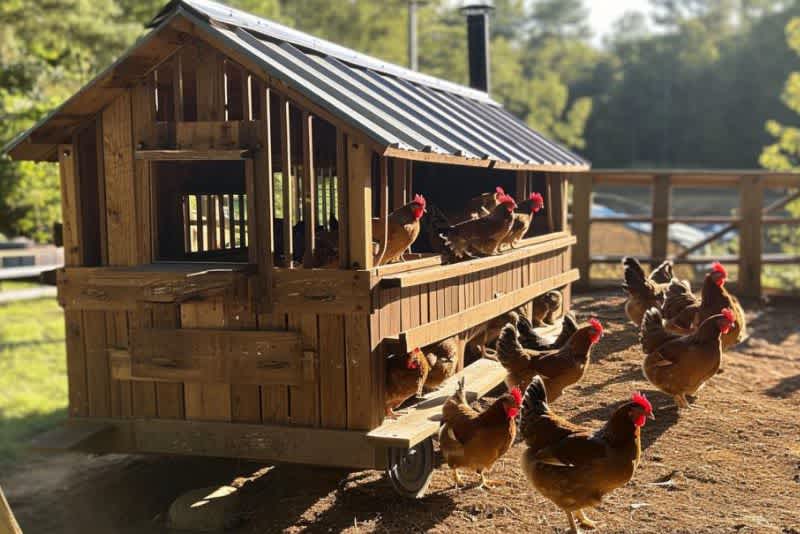
Sustainability is a big buzzword these days. As more people become aware of our impact on our environment, many are looking for ways to live more sustainably and environmentally friendly.
For those who live in urban or suburban areas, this may seem like an impossible task. However, backyard farming has been gaining popularity as a way to live sustainably within city limits.
One key tool for successful backyard farming is the chicken tractor, a composting system that uses chickens' natural behaviors to improve soil and fertilize crops. This article will explore what a chicken tractor is, how it works, and its benefits for sustainable backyard farming and raising chickens.
What is a Chicken Tractor?
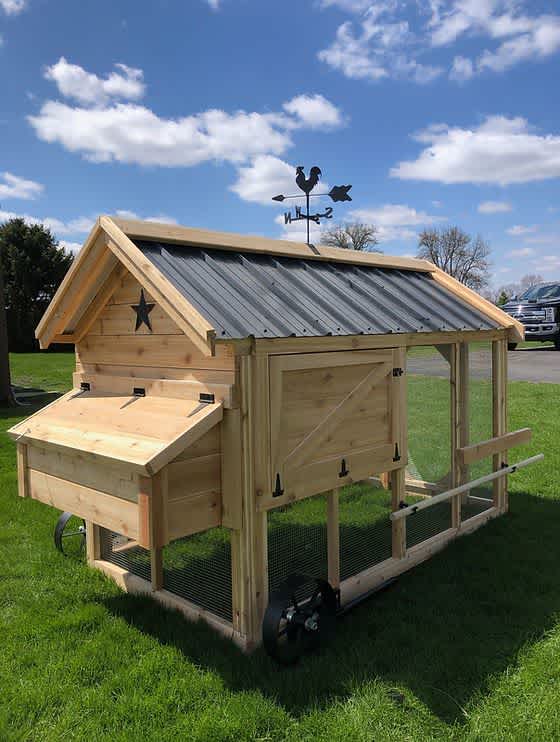
First introduced in the book "Chicken Tractor: The Permaculture Guide to Happy Hens and Healthy Soil," by Andy Lee and Patricia Foreman, the core concept of the chicken tractor is using the natural behavior of chickens to promote fertility in the soil in a synergistic manner.
Essentially, a chicken tractor is a mobile chicken coop that can be moved around your backyard to different garden areas. Its design allows chickens access to fresh grass and bugs while protecting them from predators. The coop is usually built on wheels or skids, making it easy for birds to move around.
Understanding the Benefits of Mobile Chicken Coops
Chicken tractors have several benefits for sustainable backyard farming:
Natural Pest Control
Chickens are great natural pest controllers. They love to eat insects and other pests that can harm garden plants. Allowing a flock of them to free-range in your backyard and forage can significantly reduce the need for chemical pesticides.
Fertilizing the Soil With Chicken Manure
As chickens roam around in the pasture with their tractor, they naturally scratch and dig the ground. This action helps to aerate and loosen the soil, making it easier for plant roots to grow. Chicken manure is a potent fertilizer that adds essential nutrients to the soil.
Free-Range Eggs
Happy hens lay healthy eggs, and chicken tractors allow chickens to roam while protecting them from predators. This results in healthier and more nutritious eggs than factory-farmed chickens produce. Plus, you'll be satisfied knowing your eggs come from happy and well-cared-for chickens.
Step-by-Step Guide to Building Chicken Tractors
The best thing about the chicken tractor is that you can easily build one yourself. Here's a step-by-step guide to building your chicken coop:
Step 1: Planning
Your first step in building your first chicken tractor is planning. Consider the number of chickens you have and the size of your backyard to determine the size and design that will work best for you. You'll want to ensure enough space for your chickens to move around and access fresh grass and insects.
Coop sizes generally range from 2 to 4 square feet per chicken. This allows ample space for the chickens to lay eggs and roost comfortably. The run area for chicken coops should ideally be at least 8-10 square feet of floor space per chicken.
Step 2: Choose Materials
For a truly sustainable chicken tractor design, consider using recycled materials for its construction. You can repurpose old pallets, crates, or even an old playhouse to create the frame and walls of your chicken tractor. This not only reduces waste but also saves you money on materials.
You'll also need a wire mesh for the run area and nesting boxes for collecting eggs. Choose sturdy materials for nest boxes that can withstand the elements.
Step 3: Build the Frame
Using your chosen materials, build the frame of the chicken tractor. Make sure it is sturdy enough to withstand movement when being dragged around. A cardboard or paper template from your chicken tractor build plans can help you get the right shape.
From the materials you selected from the previous step, create the frame and walls of your chicken tractor. Additionally, using wire mesh for the run area instead of solid wood allows for better air circulation and reduces disease risk.
Step 4: Add Wheels or Skids
Add wheels or skids to the bottom of the frame to make your chicken tractor portable. This will make moving the tractor around your backyard easier without damaging the grass or plants. Choosing larger wheels or skids will also make it easier to move the tractor over uneven terrain. Wheels work better for smooth surfaces, while skids are more suitable for rougher terrain.
Step 5: (optional) Add Nesting Boxes and Perches
Your chickens need a place to lay their eggs and roost at night. To create nesting boxes, use wooden boxes or repurpose old crates. You can also add perches and a roosting bar inside the chicken coop for your chickens to roost.
Step 6: Secure the Wire Mesh
Cover the run area using wire mesh to keep your chickens safe from predators while allowing them access to fresh grass and bugs. Be wary of nails or sharp edges of chicken wire that could harm your chickens.
Step 7: Add Finishing Touches
Lastly, add finishing touches, such as a roof or handles for easy movement. Consider painting your chicken tractor with non-toxic paint to make it more aesthetically pleasing and to protect it from the elements.
Exploring Various Chicken Tractor Designs
Depending on the size of your backyard, the number of chickens you have, and your budget, you can choose from various chicken tractor designs. Some popular options include:
A-Frame Design
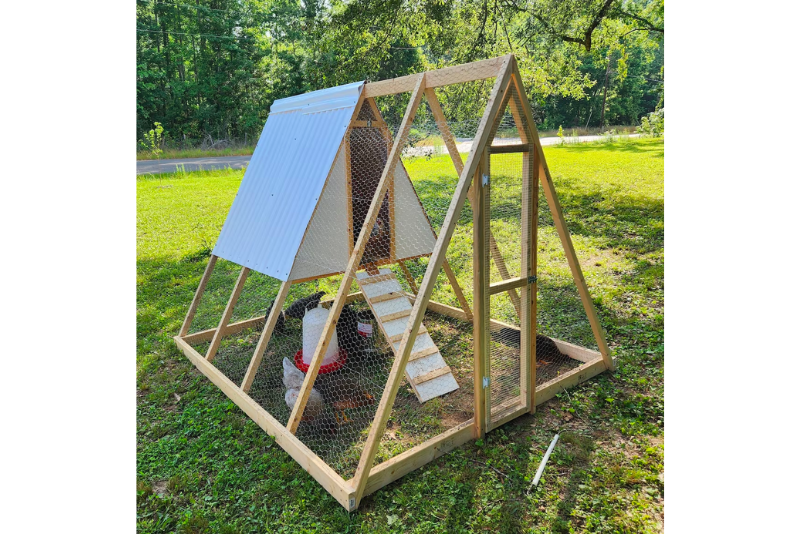
The A-Frame design is a popular choice for most chicken tractors, especially for those with limited space. It features an angled roof that allows water to run off easily and provides ample headroom for chickens to move around comfortably. However, this design may not be suitable for areas with strong winds or heavy rain as it can be less stable than other designs.
Hoop House Design
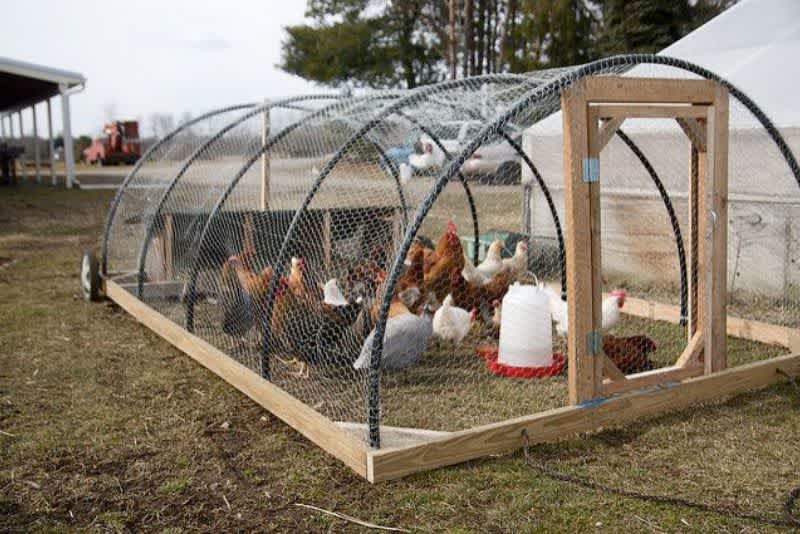
The hoop house design is shaped like a half-circle or dome, providing more headroom for chickens to move around. It also allows for better air circulation and sunlight exposure. This design is ideal for a larger backyard flock and works well in areas with harsh weather conditions. It's a little harder to build than the A-frame design, but it offers more space and protection for your chickens.
Box Tractor Design
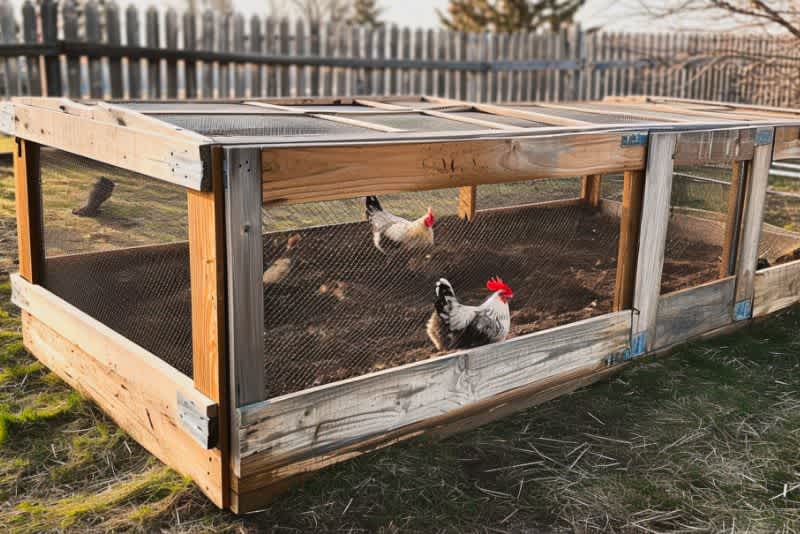
The box tractor design is a simple and easy-to-build option. It features a rectangular shape with a solid wall on one side and wire mesh on the other. This design protects predators but may not have as much ventilation as other designs.
Essential Tips for Chicken Tractor Maintenance
Maintaining your chicken tractor is crucial to ensure the health and safety of your chickens. Here are a few tips to keep in mind:
Regular Cleaning
To maintain the health and hygiene of your chickens, you must clean the chicken tractor regularly. This includes cleaning old bedding, droppings, and any leftover feed or water. A dirty chicken tractor can lead to disease and health problems for your chickens. Doing a deep clean every 1-2 weeks and spot clean daily is recommended.
Checking for Damages
Regularly check your chicken coop for any damages or wear and tear. Make sure to fix any holes in the wire mesh, repair any broken parts, and replace any rotted wood. This will ensure your chickens' safety and prolong your chicken tractor's life. Your meat chickens rely on the chicken tractor to provide protection, so it's essential to maintain its integrity.
Moving the Tractor
To prevent your chickens from overgrazing in one spot in the pasture and allow the grass in your backyard to regenerate, it's important to regularly move the chicken tractor to a different location. This also helps prevent the buildup of harmful bacteria from droppings, which might impact your eggs and allows your chickens access to fresh grass and insects. It also prevents the chickens from overgrazing in one area, which can lead to barren patches in your yard.
Sustainable Farming with Chicken Tractor
Using chicken tractors provides a safe and comfortable environment for your chickens and offers numerous benefits for sustainable farming and raising poultry here. Here are some ways in which a chicken tractor can contribute to sustainable farming practices:
Enhancing Soil Quality
One of the main benefits of using chicken tractors is their ability to enhance soil quality. As chickens are moved around in the tractor, they naturally scratch and peck at the ground, which helps aerate and fertilize the soil.
Their phosphorus rich manure also acts as a natural fertilizer, providing plant nutrients and improving soil health. Farming can deplete the soil of essential nutrients, and using a chicken tractor can help a farm replenish them, making it a sustainable practice for long-term agriculture.
Pest Control
Chickens are natural foragers who eat insects, such as grasshoppers, beetles, and ticks. By moving chicken tractors around your backyard, you can prevent the buildup of pests and insects. This reduces the need for chemical pesticides, making it a more sustainable and natural form of pest control.
Reducing Food Waste
Chickens are omnivores and can eat various food, including kitchen scraps. This makes them an excellent addition to sustainable farming practices as they can help reduce food waste. Instead of throwing away leftover fruits, vegetables, or grains, you can feed them to your chickens.
Before feeding your chickens kitchen waste, research what they can eat, like small amounts of bread, and cannot eat, like avocados. Not only does this reduce waste, but eating it also provides additional nutrients for the chickens and can save you money on feed costs.
Promoting Animal Welfare
Building a chicken tractor benefits both chicken health and sustainable farming. With various designs and easy upkeep, these tractors enhance soil quality, control pests, and reduce waste.
They offer chickens a natural habitat, allowing for behaviors like foraging and dust bathing. This setup supports animal welfare and a sustainable farming system, reducing your carbon footprint. It's an ideal choice for backyard farmers aiming to advance their farming methods.
Consider building your chicken tractor and join the movement toward sustainable farming! It's an excellent investment for backyard farmers looking to improve their practices.
Keep track of all your cattle with the #1 Cattle Management Software
Try out Ranchr today for free